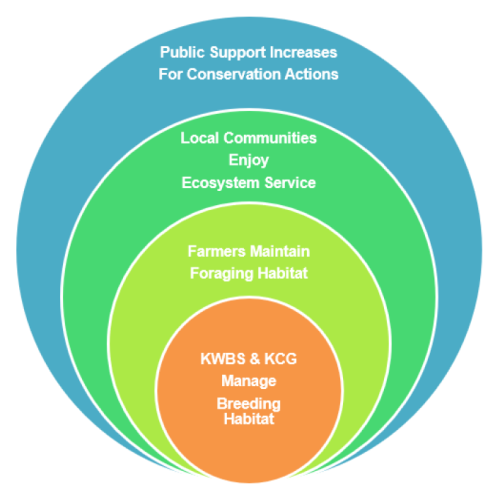Rehabilitating local wetlands and reinvigorating local culture via Pheasant-tailed Jacana Conservation in Meinong, Kaohsiung City, Taiwan
30.07.2023
SUBMITTING ORGANIZATION
Taiwan Wild Bird Federation
OTHER CONTRIBUTING ORGANIZATIONS
Kaohsiung Wild Bird Society
Meinung People’s Association
DATE OF SUBMISSION
26/05/2023
REGION
Asia
COUNTRY
Chinese Taipei
KEYWORDS
Community conservation, eco-friendly agriculture, agricultural wetlands, human-wildlife interactions
AUTHORS and AFFILIATIONS
Meinung People’s Association
Fairy Pitta Conservation Association
Meinong Farmer’s Association
The Tourism Bureau of Kaohsiung City Government
Kaohsiung City Government
Forestry Bureau Council of Agriculture, Executive Yuan
WEB LINKS
TWBF Webpage (Mandarin/English):
https://www.bird.org.tw/about/82
Kaohsiung Wild Bird Society Webpage (Mandarin):
https://www.kwbs.org.tw/
https://kwbs.org.tw/jacana/
Meinong Lake Jacana Conservation Area (Mandarin):
https://www.facebook.com/groups/mljca
Summary Sheet
The summary sheet for this case study is available here.
History of Taiwan’s Pheasant-tailed Jacana population
In much of its global range, the Pheasant-tailed Jacana is a common species. However, in Taiwan they are considered an uncommon resident. First recorded in Kaohsiung City in 1865 by British diplomat and naturalist Robert Swinhoe, their historical range extended from Yilan in the northeast down the whole of the west coast to Pingtung and Taitung in the south. But this population almost disappeared by the end of the 20th century due to pesticide use, poisoning, and, especially, habitat loss. The wetland habitat that the jacanas relied on for breeding and roosting disappeared as Taiwan’s economy rapidly developed in the 1960s.
By the late 1980s, only 50 birds were thought to remain, in Tainan City’s Guantian District. This area, Taiwan’s top water caltrop producing region, supplied the birds with critical habitat for breeding. They could use the floating leaves and stems for nesting materials and forage for insects under the aquatic plants’ leaves. It was here that conservation efforts for the jacanas began in earnest. In the year 2000, Taiwan’s largest bird conservation organization, the Taiwan Wild Bird Federation, along with Wetlands Taiwan, applied to the local government to create a conservation area in Guantian for the jacanas on land owned by the Taiwan Sugar Corporation. The 15-ha Pheasant-tailed Jacana Conservation Park, as it would later be known, would be managed by local NGOs, first by the Kaohsiung Wild Bird Society (KWBS) and later by the Wild Bird Society of Tainan. The park spearheaded a number of community conservation efforts and ultimately led to conservation success. The success of this project has been remarkable: over 1,000 birds have been counted in annual surveys done for the last six years running.
However, as the population has increased, notes of caution arose. Major concerns included the genetic diversity of the Guantian population, the risk of poisoning, an ageing farmer population, and the threat of possible land development.
Aside from Guantian, small population pockets exist across Taiwan, confined to various water caltrop fields, artificial wetlands, or large ponds in stagnant floodplains. These are characterized as being sporadic and isolated environments which do not provide sufficient habitat or food to sustain larger populations. As many of the birds rely on agricultural cultivation cycles, once the harvest is over, fields are dried until the next cultivation period begins. The jacanas then possibly face a period of high mortality due to the disappearance of both roosting habitat and foraging areas. Therefore, more stable breeding habitat and year-round foraging areas are necessary to expand the population and improve its resilience.
It was with this in mind that individuals and conservation groups in neighboring Kaohsiung City began to discuss the creation of a second jacana conservation area to strengthen conservation actions for the species.
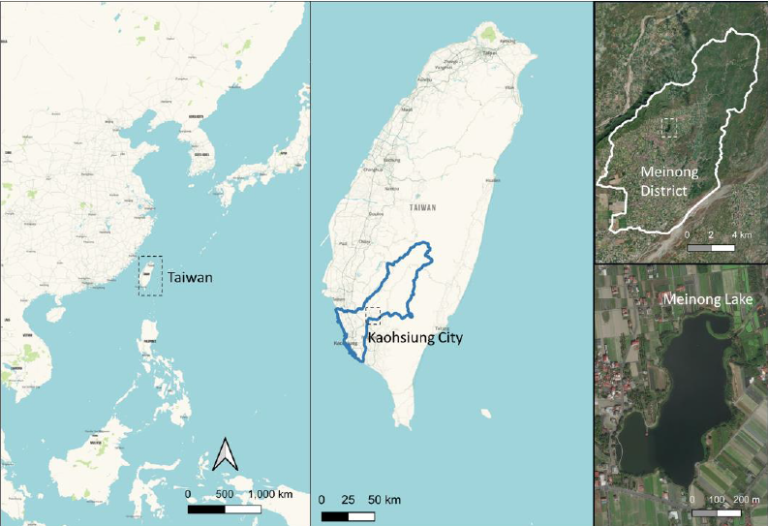
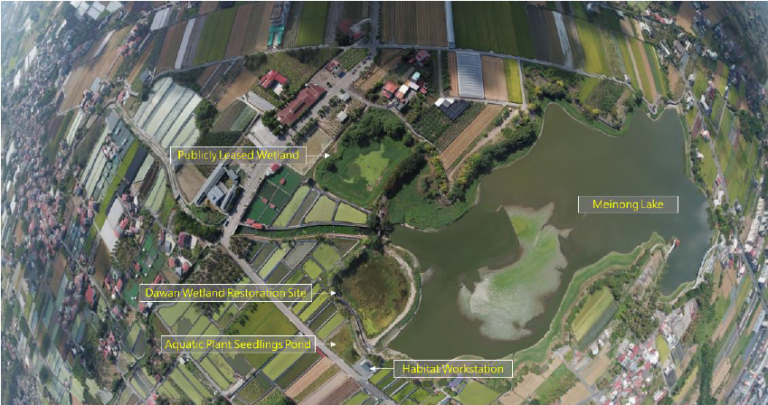
Moving to Meinong
Kaohsiung City’s Meinong District is an important area for Taiwan’s Hakka population, which first settled in the area in 1736. Today over 95% of Meinong’s population is still ethnically Hakka and many remain engaged in agriculture. One of the major local crops is white water snowflake Nymphoides hydrophylla, an edible plant tied closely to Hakka cuisine and culture.
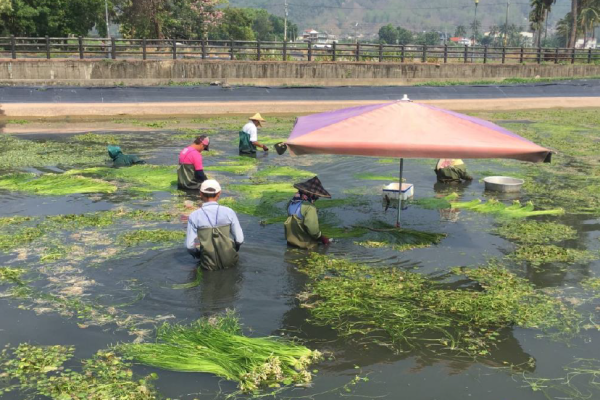
Initially a wild aquatic vegetable harvested from nature, it was part of the natural scenery when Hakka settlers first arrived. It’s one of the few native aquatic plants among the floating-leaf varieties cultivated in large quantities in Taiwan. Grown in ponds requiring water levels adjusted at designated intervals, these areas traditionally provided excellent foraging for wintering jacanas. People in Meinong developed a deep relationship with the birds, locally referred to as water fairies due to their ability to walk gracefully on the water.
Traditionally farmers in the area cultivated rice all year round. However, in 1895, during the Japanese colonial period, tobacco was introduced as a cash crop and grown from October until January before the land then switched back to rice cultivation the rest of the year. With this new cultivation scheme, as well as the reduction of natural wetlands, jacanas slowly stopped returning and those that did only remained for the winter. Meanwhile, in 1975, Chung Hwa-jin began to cultivate white-water snowflake in small quantities, try to make the local supply more stable.
In 2000, a major agricultural shift took place. The government stopped purchasing tobacco and people began considering newer land use options. Farmers looked to white-water snowflake, with its ties to local history, culture, and the environment, as well as the fact it could be harvested 3-4x a year, and began cultivating it in earnest. With the habitat created by the newly expanded planting areas, jacanas could be seen returning to Meinong. However, after the ponds were drained and cleaned after each harvest, they were not useable to the birds, especially during the breeding season.
Taking this into consideration, local people wanted to see if it was possible to create habitat to accommodate breeding jacanas. Therefore, in 2017, Liu Hsiao-shen, executive director of the Meinong People’s Association, and his wife Huang Shu-mei, both members of the KWBS, applied to rent land adjacent to Meinong Lake for this purpose. Formerly known as Zhongzheng Pi, at 21 ha Meinong Lake is Kaohsiung’s second largest lake. Initially created as a reservoir to help with crop irrigation, it has since become an important site for both resident and migratory bird species. It seemed to be the perfect spot for jacanas to breed. This supposition was proven by the eight hatchlings counted year. These were followed by six hatchlings in 2018, 10 in 2019, and 17 in 2020. Efforts were further bolstered in 2020 when Liu and Huang began fundraising to do a public land lease of wetland habitat. They accumulated 69 donors, including both individuals and local groups, pooling enough money to rent the land now known as the Pheasant-tailed Jacana Publicly Leased Wetland. It contains 1 ha of land including 0.5 ha of water space.
That same year, The Tourism Bureau of Kaohsiung City Government (TBKCG) announced its 2020 Meinong Lake Aquatic Environment Improvement Plan which aimed to focus on enhancing the local ecosystem and the environment around Meinong Lake. Kaohsiung’s largest bird conservation group, the KWBS, took this opportunity to pitch the Kaohsiung Aquatic Ecosystem Improvement and Public Participation Plan using Pheasant-tailed Jacanas as an Indicator Species to the TBKCG. The group contended that through habitat protection and creation, the results of conservation efforts could be quantified. Furthermore, by cooperating with the public sector on land management, larger areas of wetlands and floodplain could be adopted, leading to a larger habitat area which would in turn create more opportunities for breeding success and overall ecosystem conservation. Lastly, by providing a safe breeding environment through habitat creation alongside the already existing white-water snowflake paddy fields, the area could become as a breeding base for the population. Habitat restoration efforts could also have the effect of bringing back the disappeared aquatic plants and ecosystems formerly found at Meinong Lake. During negotiations, the tourism bureau agreed to help prepare to site while the KWBS agreed to assist in the subsequent public adoption of the land, management of the property and maintenance work. An agreement was reached on the proposal and site planning got underway.
The Meinong Lake Jacana Conservation Area

In February 2021, the KWBS officially adopted the land and began management of the site. The Meinong Lake Jacana Conservation Area (its official name) is a total of 0.8 ha. This includes the Dawan wetland restoration site, an aquatic plant seedlings pond and habitat workstation. Operations are all volunteer-based, with its management team consisting of Liu, Huang, and Chung Yi-hsin. Meanwhile, the workstation is run by Chen Po-hao. All are from Meinong aside from Chung who hails from neighboring Pingtung County, and both Chen and Huang have had experience in both volunteer management and habitat restoration.
Volunteers are the heart of the operation, doing habitat work, environmental education, coordinating with local businesses, and cultivating eco-tourism opportunities for the area. Due to the strong networks already in place via longstanding and well-established local bird societies as well as civic NGOS, there are already 40 regular volunteers and 50-80 volunteers on reserve. Beginning in March of 2021, the KWBS organized a series of on-site activities for those interested in volunteering. Some focused specifically on outreach. This is of particular importance as MLJCA volunteers are frequently engaging with the public, introducing local birds and discussing wetlands conservation in Mandarin, Taiwanese, and Hakka. This has been effective in gaining support from local farmers who may have had misconceptions about jacanas and their roles in wetland ecosystems. For some, they gained a new appreciation for this species which they now know eats insects that could harm their white-water snowflake crop.
The MLJCA has already welcomed many local and school groups to either help with the habitat work or for educational programs offering insight into local ecology and Hakka culture. Though only just officially opened in 2021, by 2022, the MLJCA welcomed over 900 students from schools such as Shih Chien University, National Pingtung University, Hebin Elementary school, Wu-Fu Junior High School, Meinong Elementary School, Guang Sing Elementary School, National Chimei Senior High School, Kaohsiung Municipal Kaohsiung Senior High School, National Taiwan University, Dashe Elementary school, Londu Elementary school, and Jhengsing junior high school. Also, community groups and local birders have joined in to lend a hand as well.
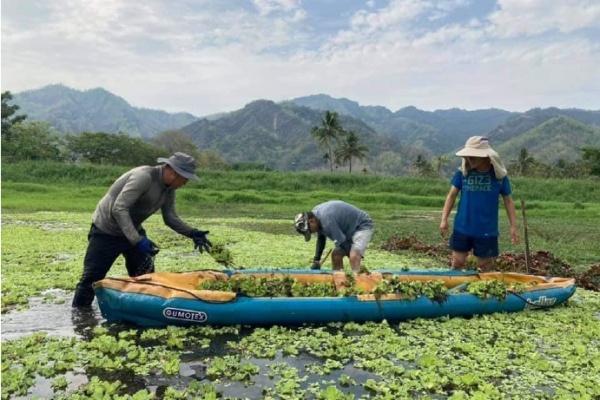
All interest and support are welcomed as doing such community-based conservation work and restoring wetland habitat is no easy task. In 2021, the whole area of the Dawan site had to be returned to a wetland style habitat after having been converted to a grassy field years ago. First grasses and weeds had to be removed. Then the area had to be prepared for the return of water to what had become dry land. After this, plants were selected that reflected the local ecosystem dynamics and provided for the habitat and foraging needs of the jacanas. In March 2021, the Dawan site saw its first aquatic vegetation. In small amounts, water caltrops from Guantian as well as prickly water lilies were placed on site. The prickly water lilies were chosen as they are big, leafy, and lay on the water surface. On 1 May 2021, 62 volunteers gathered at the MLJCA for the Big Plant Day. During this time, the bulk of the vegetation was added including more water chestnuts and prickly water lilies, as well as a number of smaller water plants such as pygmy water lilies, nymphea lotus, water primrose, Asian lizard’s tail, yellow pond lily, Hygrophilia pongocalyx, Rotala Rotundiflora, and water hyssop. The aquatic plant seedlings pond has many of these species on hand as a backup in case something happens to those at Dawan. The event even got national media coverage, with Lin Kun-hai, the KWBS’s General-Director, and the MPA’s Liu talking about the new project with reporters.
Since work in the area began in 2017, clear increases in the number of wintering jacanas have been seen. Wither the additional support from the creation of breeding habitat and even starker increased has been noted even though it has only been one year.
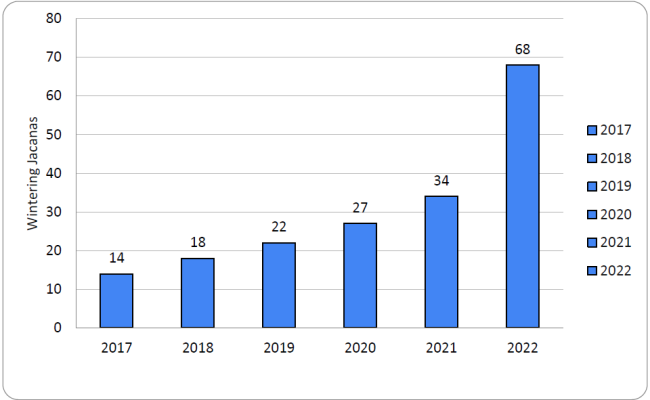
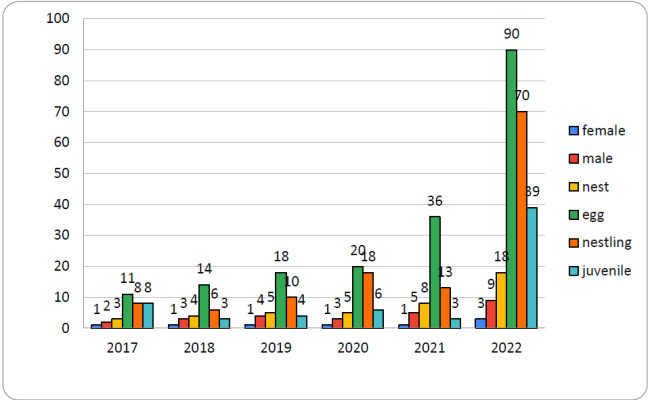
In Dawan, 2021 saw three nests and eight chicks recorded at the site. Just one year later, after much habitat work and community interactions, there were 9 nests and 39 juveniles recorded around Meinong Lake. In order to ensure information about jacana numbers is continuous and accurate, updates about the MLJCA and its feathered residents are provided by diligent and social media savvy volunteers. They use a Line Messenger group where there is a near-constant exchange of information and photos. Meanwhile, a Facebook group has been created where regular updates including photos and videos are shared with the public. As Facebook is the most widely used form of social media in Taiwan, it has brought a lot of attention to the work being done by the MLJCA volunteers and already has over 3,700 followers.

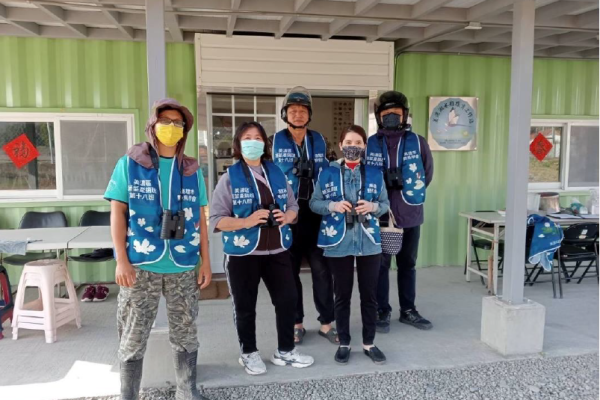
In terms of local engagement outside of the conservation area, the MLJCA staff work in earnest with the local farming community. White-water snowflake, with its historical and cultural value as well as relatively fast harvest time, had widespread support for its cultivation. One of the major initiatives in Meinong is a farmer patrol group which was formed in coordination with the Meinong District Vegetable Agricultural Production and Marketing Group. In this collaboration, which is supported by Taiwan’s Forestry Bureau, a group of six to 12 farmers will check local habitat every month (about 6km sq). This not only connects the farmers to the project, it also helps the farmers to integrate the jacana conservation into their local routines. Communication lines and supports are also being established so that if a farmer has jacanas breeding in their white-water snowflake pond, the MLJCA will help them sell their harvest after chicks mature. Furthermore, starting in 2023, if the jacanas are allowed to breed in a farmer’s white-water snowflake pond, they will also be provided with free product packaging once their harvest comes in. Next, as some farmers might not want to wait for the jacanas to breed before doing pond maintenance work or harvesting, the MLJCA staff will provide free aquatic plant seedlings so they can diversify their ponds and allow for the jacanas to have other options instead of white-water snowflake. All of the species provided are local or non-damaging to the local environment. Lastly, special efforts are being made by the MLJCA to work with the next generation of farmers to help them do eco-friendly farming.
Moving Forward
Looking towards the future, more work is planned to improve habitat quality, get more deeply involved in the community, encourage jacanas to breed in the area, and share their story to encourage more people to do jacana-friendly agriculture. In the near term, the staff and volunteers plan to focus on the best forms of germination of prickly water lilies to help improve habitat availability for the jacanas. They will also try to improve the quality and function of the Meinong Lake Jacana Conservation Center and breeding area. Research is also underway on how to have jacanas breed in the white-water snowflake ponds without negatively impacting farmers profits as well as to promote jacana-friendly white-water snowflake cultivation. The MLJCA is already working with government agencies on how to turn the pheasant-tailed jacana into an IP and use it for marketing local agricultural products that are wildlife-friendly.
Plans for designing light ecotourism are also underway. It is hoped that guests can come to experience the local ecology and visit sites related to Hakka culture, including white-water snowflake paddies, paper umbrella and blue dye learning stations, and historic sites. The umbrella species will remain the water fairies yet it is hoped that many other species can also benefit from this work. Improving economic development for local communities further via cultural and ecological tourism with gain more support for conservation actions.
In the longer term, once the situation at Dawan has stabilized, the KWBS plans to look for other suitable areas nearby where they could use the seedlings from the seedling pond to create more jacana habitat. The staff also plans to work with various stakeholders to encourage creation of jacana-friendly breeding habitat throughout Taiwan. One example already in the works is a collaboration with the neighboring Liudui Hakka Cultural Park to develop their own experimental pond and hopefully bring jacanas there.
Appendix 1: Overview of Activities Done by the Kaohsiung Wild Bird Society and the Meinong Lake Jacana Conservation Area:
B. Coordinated Efforts with Government Agencies
- The Meinong Lake Jacana Conservation Center Building and Dawan site are both adopted from the government and can be considered government
- In 2022, the Forestry Bureau provided NTD$100,000 for youth education initiatives
C. Coordinated Efforts with Local Community
- Most of the volunteers are local people and so all activities reflect the community and local history and culture. This includes Hakka tie-dye activities, Hakka language classes for birds, Hakka music events, and other Hakka cultural activities
E. Activities Inside the Conservation Area
- Raising water plants for conservation
- Holding environmental education events for students
- Creating breeding habitat for jacana
- Creating a Hakka botanical garden
- Bird watching
- Aquatic plant planting
- Searching for aquatic insects
- Slacklining on aquatic plants at seedling pond
- Naming birds in Hakka
G. Ecological Successes Based on Efforts
- Wetland habitat recreation—The Dawan habitat was desert but now already full of watergrass and aquatic plants. Jacanas and numerous other species such as turtles, frogs, snakes and freshwater fish use it.
- Staff are working to help neighboring white-water snowflake farmers diversify their ponds at allow for multiuse agricultural areas.
- Seedlings of aquatic plants have been shared with Hualien. These include prickly water lily, and water caltrops
Appendix 2: Structure and Methodologies Used by Meinong Lake Jacana Conservation Park towards Conservation and Satoyama Initiatives
Cycle of Promotion of Mixed-Use Agricultural Landscapes for Wildlife Conservation Via the Meinong Lake Jacana Conservation Area
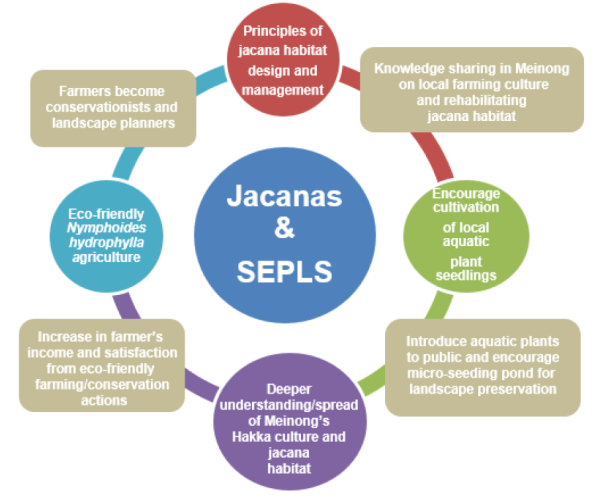
Spread of Landscape Conservation Ethos and SEPL Protection via the work of Kaohsiung Wild Bird Society and Kaohsiung City Government
